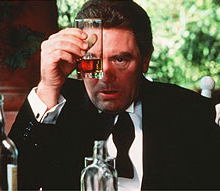 |
| Malcolm Lowry |
The real Lowry lost manuscript
Posted on September 29, 2010
Malcolm Lowry was born in 1909, in New Brighton, a small town for which I have a soft spot, just “over the water”, as we say, from Liverpool. He was a restless spirit who wanted to write, and did not want to follow his three older brothers into the family cotton-broking business. At the age of 18, he set sail from Liverpool as a deck-hand on a freighter bound for Yokohama.
Lowry’s first novel, Ultramarine, appeared in 1933 when he was 24 years old. Contrary to popular belief, Lowry did not leave the manuscript of this first novel in a taxi. The manuscript was stolen, yes, but it was in a briefcase taken from the convertible car of the publisher’s editor, Ian Parsons. Lowry alleged that he was forced to re-write the entire work in a matter of weeks because of this loss, but a carbon copy existed, supplied by his friend, Martin Case, who had typed the final manuscript then kept the carbon copy which Lowry had chucked in the bin.
Ultramarine tells the story of a young man growing up during a voyage to the Far East — so far, so autobiographical. Ultramarine was not a commercial success; Lowry was accused of plagiarism and he spent much of the rest of his life trying to suppress the book.*
After Ultramarine appeared, Lowry began travelling through Europe with his friend and mentor Conrad Aiken, got married to the writer Jan Gabrial in Paris, and, in 1935, began a novel called In Ballast to the White Sea.
Also in 1935, Lowry moved to New York. He had begun a deep and meaningful relationship with alcohol at an early age, and this relationship continued while he and Jan moved to Los Angeles, then Mexico. In Mexico, Lowry began what would turn out to be his masterpiece, Under the Volcano — the work of genius that the alcoholic sobered up long enough to write.
By 1937, Lowry’s drinking caused Jan to leave him, and he was jailed, then deported from Mexico in July 1938. In Los Angeles, he met Margerie Bonner, an aspiring writer and former silent-film child star. When Lowry moved to Canada after his American visa expired, Bonner followed him. They were married in December 1940. For the next 14 years, they lived as squatters in a cabin without plumbing or electricity at Dollarton, up-inlet from Vancouver.
The cabin was an isolated place. The Lowrys had little money, apart from Lowry’s life-long allowance from his father. In 1944, their house burned down, immolating almost everything they owned, including what had become a 1,000-page draft of In Ballast to the White Sea, nine years of literary labour, which Lowry never re-wrote.
 |
| Malcolm Lowry |
In February 1956, Lowry and Margie came to live in another seaside town: Ripe, on the south coast of England. They were not happy. When Lowry threatened Margerie with a broken bottle (she said), she fled. She returned to the house on the morning of 27 June 1957 to find Lowry dead from an overdose of sleeping pills.
In a nice twist on the planet of lost manuscripts, before T.E. Lawrence burned his personal library, he saved the books he liked. One of these was a relatively unknown seafaring novel called Ultramarine. What would T.E. have made of the truly disappeared In Ballast to the White Sea? An early draft of the novel has turned up in Jan Gabrial’s papers since her death, but the Dollarton manuscript has gone forever.
* Lowry was accused of plagiarising Nordahl Grieg’s The Ship Sails On, published by Knopf in translation from the original Norwegian in 1927. Lowry actually admitted in a letter to Grieg in 1938 that “Much of Ultramarine is paraphrase, plagiarism, or pastiche from you.” See: Harvey Breit and Margerie Bonner Lowry (Eds.) The Selected Letters of Malcolm Lowry, London, 1967, p16.




No comments:
Post a Comment